As I mentioned in my previous post, since half way through this lot, painting has often seemed more like a chore than a pastime. However, there is always the feeling of satisfaction following the completion of an arduous task and that's pretty much how I feel now.
"Praise be.... There are no more Brits in the lead pile!"
Enough said.
This army comprises twenty eight units of 'formed infantry'; three skirmish units of Riflemen; eight units of cavalry; eight guns and crew, plus four limbers; twenty three extra skirmish stands; ten command stands.
All, except six KGL Light Infantry figures (Warlord) are FRONT RANK MINIATURES.
All were painted by myself using enamels.
Flags are a pretty even split between GMB Designs and Flags for the Lads. Both are excellent quality; GMB are printed on slightly thicker, shinier paper.
Bases are home cut 2mm MDF (square or officer stands), or War Bases (round for skirmishers). Basing is ink washed and dry brushed sand and grit finished off with foliage by Woodland Scenics (coarse turf: a burnt grass + yellow grass mix). Infantry / cavalry frontage is 45mm per stand.
The British infantry elements were the hardest to settle on because of the 'special troops' required for 1st, 7th and Light Divisions. Consequently, there are rather more special units, such as Highlanders, Guards and Brunswick Oels, than I would have chosen to do otherwise. Indeed, these three divisions grew the army well above the numbers I originally planned and in response the French army grew to match it - a definite case of mission creep.
At first glance the OOB seems incomplete. However, that is because I'm scaling my divisions (my basic command groups) at one unit to a thousand men and, more often than not, this means I need less units than were actually present in the divisions to make the divisions up. Furthermore, table space means collecting more would be practically pointless - I could never physically fit them on my table in any meaningful way.
A classic example of my incomplete OOB is having no 42nd (Black Watch) Highlanders for 1st Division. 1st division usually mustered about 7,500 men which works out at seven or eight units. Looking at the unit composition of 1st Division I decided it should comprise two Guard units, two Highland units (dropping one), one Highland Light unit, two KGL units (dropping two), and possibly one other British line unit (dropping one or two).
Gentlemen of the League (especially the former and serving officers of the Black Watch), please note that the renowned 42nd were dropped simply because I had flags for the Camerons and the Gordons and no flags for the 42nd - sorry, guys.
BTW, to the readers who kindly volunteered a donation of their spare flags to this project, thank you again.
The number of Portuguese Line units also seems a little low but, at one unit to one thousand men, there are enough Portuguese Line to furnish three Anglo-Portuguese divisions.
Outside of the afore mentioned divisions, the units I chose to paint had more to do with the flags I had than any specific OOB: They all fought in the Peninsular, and that's enough for me.
With the infantry figures I have, I can field five infantry divisions: 1st Division, Light Division and three other divisions, possibly including 7th Division (The Mongrels) all at the same time. Not bad, at all, and certainly enough for a big game.
A note on skirmishers: The number of skirmish figures attached to a unit does not represent proportionally accurate numbers. The number of stands (each two figures) equates to the unit's basic 'in game' skirmishing factor: A line unit has a skirmish factor of 2, so it gets two stands (four figures) even though this is proportionally too high for the number of figures in the unit; I could have halved the stands, or based less figures individually, but it didn't look as good. The British also have numerous independent skirmish stands that are used to bolster a division's overall skirmish factor - representing attached Rifle coys, Cacadores and such.
The composition of the cavalry (one unit equates to 500 troopers) is a total fudge because the variation in a cavalry division was quite extreme from one year to the next and I wasn't prepared to cater beyond eight units in this department. However, given that I only use a light or heavy cavalry type classification (with quality adjustments), and one unit can easily substitute for another within that confine, I decided to go for a 50 / 50 split. It remains to be seen if I'm right on this.
It all makes sense, kind of, to me at least, and here is my 'army'.Two army commanders in Wellington and Beresford; plus an Officer of Engineers (an Officer of Engineers is often useful for scenarios).
Eight division / brigade / command group officer stands including two most definitely for the cavalry.
Before you all jump down my throat, I know Picton didn't wear the top hat and civilian coat in the Peninsular but, he wouldn't look like Jack Hawkins without it.
The Cavalry: Eight units, each 12 figures strong.- 1st and 3rd Dragoons; 1st and 2nd Dragoons KGL.
- 13th and 14th Light Dragoons.
- 10th Hussars
- 10th Portuguese cavalry
- Four guns (British Foot Artillery) plus two limbers.
- Two guns, (British Horse Artillery) plus one limber.
- Two guns, (Portuguese Artillery) plus one limber.
- 53rd Foot (Shropshire).
- 88th Foot (Connaught Rangers).
- 3rd Foot Guards (Scots Guards).
- 1st Battalion Coldstream Guards.
- 79th Foot (Cameron Highlanders).
- 92nd Foot (Gordon Highlanders).
- 50th Foot (West Kent).
- 27th Foot (The Inniskillings).
- 5th Foot (Northumberland).
- 9th Foot (East Norfolk).
- 11th Foot (Devonshire).
- 24th Foot (Warwickshire).
- Brunswick Oels (7th Division).
- Chasseurs Britannique (7th Division, but can double as something else).
- 1st Battalion KGL
- 2nd Battalion KGL.
- 97th Foot (Queen's Germans, and with almost identical flags, can easily double as a third KGL unit).
- 8th; 9th; 12th; 13th; 16th; 21st.
- 52nd Foot (Oxfordshire) Light Infantry.
- 51st Foot (2nd West Riding) Light Infantry.
- 43rd Foot (Monmouthshire) Light Infantry.
- 71st Foot Highland Light Infantry.
- 3rd Cacadores
- 95th Rifles (skirmish units) x3
Finally, extra skirmishers for deployment to the divisional skirmish musters, each stand 2 figures (pictured above, out in front, on round bases):
- 6th Cacadores (5 stands).
- 8th Cacadores (5 stands).
- 95th Rifles (4 stands).
- 60th Rifles (3 stands).
- KGL Light Infantry (3 stands).
- Oels Jagers (3 stands).
The two pictures above shows just how much that this is the case: Crammed in they are, crammed into a strictly allotted space.

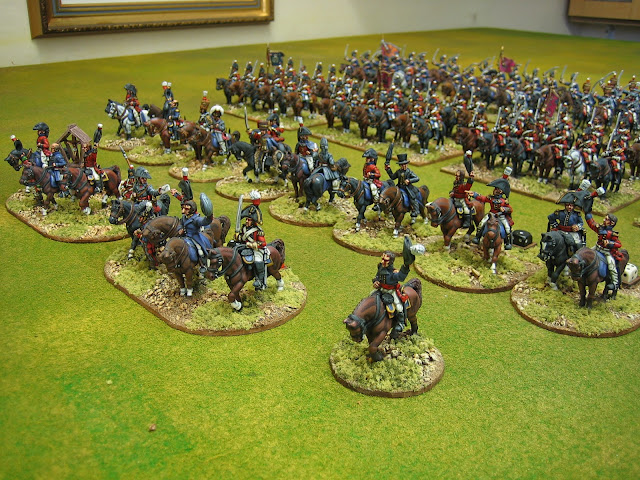


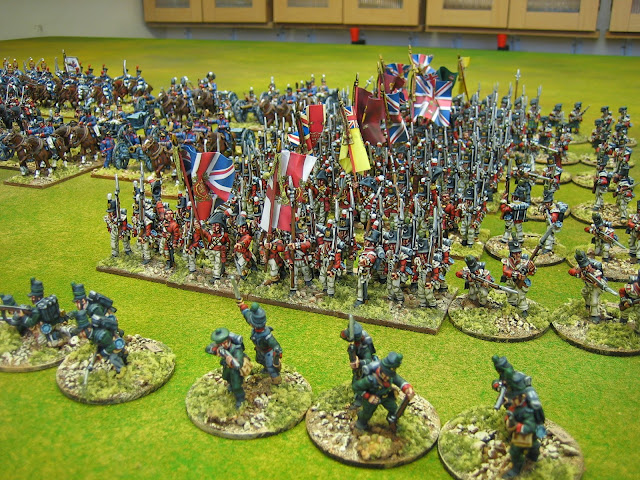
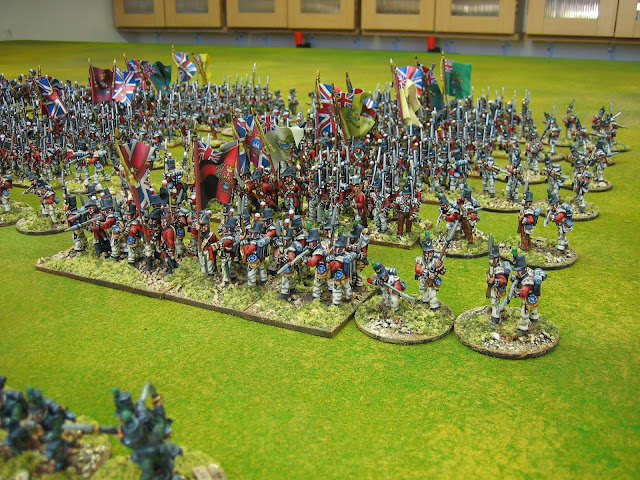

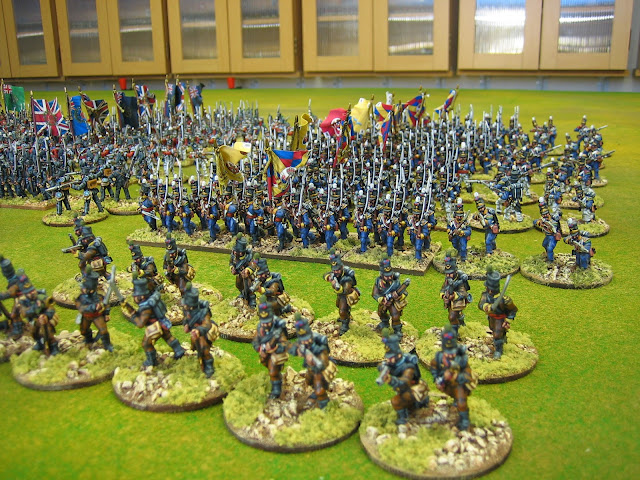



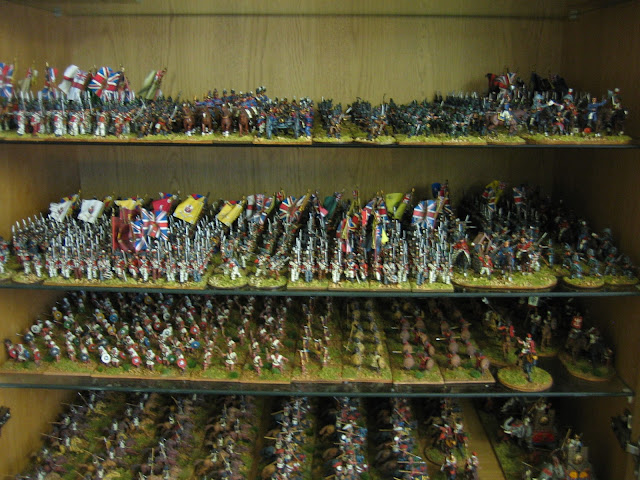

15 comments:
I'm really impressed with the scale and quality of that marathon paint job. Also very brave of you to reveal your full OOB and risk the brickbats of all those whose favourite units have been shunned - I'll chuck a couple for the 28th Foot and KGL Hussars (preferably the 1st)... ;o)
That's a superb looking force and completely understand your partial bath tubbing of the forces available.
Awe inspiring army. What a tremendous amount of time and work has gone into this project. I also like the Picton wearing overcoat and top hat.
Do you Garde de Paris in your French order of battle? They are quite colorful.
Thank you for your kind words.
DAF. I do have the Garde de Paris but not in the early green uniform. I have them in the white uniform in which they operated from June 1808. I have two battalions of them.
Wow this is a fantastic collection James and as others have said, your toys, your rules when it comes to the logic of how many units you painted and what you left out. I personally have about six units of Highland infantry in my British Napoleonic collection, most painted when I was a callow youth in my early thirties! It was only some time later that I realised that some of the regiments I had done spent the entire period in India....ah well, my toys, my rules in this case! 😜
Wonderful! Well worth all the strenuous effort involved. I suspect most of us can only dream of having such impressive Napoleonic armies. :-)
Cheers,
David.
That is an impressive sight James! Planning armies by the yard though is a new one on me.
I love this kind of "army on parade" post. Beautiful figures, as always. I envy your ability to focus on a project, and produce these kinds of numbers.
Your blog is a feast for the eyes and a source of inspiration for many of us.
I am looking for figurines to recreate the 71st of foot with their very special headdress.
Can you tell me where to find these figurines? If it is a conversion can you tell me how to proceed?
For close ups of the 71st go here: http://olicanalad.blogspot.com/2016/09/the-scots-of-howards-brigade-92nd-and.html
As I understand it, the headdress of the 71st was a standard shako with a highland bonnet pulled over the top. This caused the top of the shako to become more rounded than was usual.
I simply took standard light infantry and filed off the top edges of the shako, then painted it dark blue and put a chequered band around it. I did my band much deeper than it should be to get the pattern to stand out. The chief reason for this unit being depicted in firing line was to make filing and painting easier than it would have been on marching figures (with a musket and bayonet in the way). Note that the officers wore plain, unbonneted, shakos.
Sorry, that link will not work. Go to the Napoleonic Peninsular War Project label in the side bar and scroll back a few whole pages. There is a piece on them there.
Impressive and superb!
Good game.
Thats Really great Blog . Thank you So Much For Shareing
Our offer for the export of Katowice rubble directed to individual clients as well as companies. We can provide a container for rubble, as well as the ability to transport the rubble directly on specialized vehicles. For more at rubble
An impressive collection and an even more impressive strength of will to stay focused all the time required!
Thank you for sharing 😄
Congratulations on a marvellous and life fulfilling challenge. The question of storage was eloquently identified and I too have tried to limit my collection to shelf space, but failed. I wonder how many of us face some disappointment with how to display our massed ranks rather than secrete them away in a plastic box under a bed.
Post a Comment